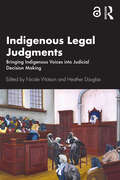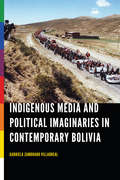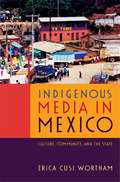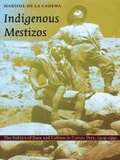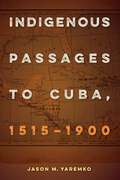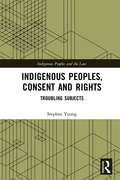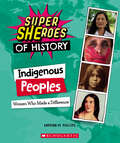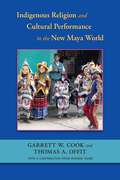- Table View
- List View
Indigenous Ingenuity: A Celebration of Traditional North American Knowledge
by Edward Kay Deidre HavrelockCelebrate Indigenous thinkers and inventions with this beautifully designed, award-winning interactive nonfiction book—perfect for fans of Braiding Sweetgrass. <P><P>Corn. Chocolate. Fishing hooks. Boats that float. Insulated double-walled construction. Recorded history and folklore. Life-saving disinfectant. Forest fire management. Our lives would be unrecognizable without these, and countless other, scientific discoveries and technological inventions from Indigenous North Americans. Spanning topics from transportation to civil engineering, hunting technologies, astronomy, brain surgery, architecture, and agriculture, Indigenous Ingenuity is a wide-ranging STEM offering that answers the call for Indigenous nonfiction by reappropriating hidden history. <P><P>The book includes fun, simple activities and experiments that kids can do to better understand and enjoy the principles used by Indigenous inventors. Readers of all ages are invited to celebrate traditional North American Indigenous innovation, and to embrace the mindset of reciprocity, environmental responsibility, and the interconnectedness of all life.
Indigenous Intellectuals: Knowledge, Power, and Colonial Culture in Mexico and the Andes
by Yanna Yannakakis Gabriela RamosVia military conquest, Catholic evangelization, and intercultural engagement and struggle, a vast array of knowledge circulated through the Spanish viceroyalties in Mexico and the Andes. This collection highlights the critical role that indigenous intellectuals played in this cultural ferment. Scholars of history, anthropology, literature, and art history reveal new facets of the colonial experience by emphasizing the wide range of indigenous individuals who used knowledge to subvert, undermine, critique, and sometimes enhance colonial power. Seeking to understand the political, social, and cultural impact of indigenous intellectuals, the contributors examine both ideological and practical forms of knowledge. Their understanding of "intellectual" encompasses the creators of written texts and visual representations, functionaries and bureaucrats who interacted with colonial agents and institutions, and organic intellectuals.Contributors. Elizabeth Hill Boone, Kathryn Burns, John Charles, Alan Durston, María Elena Martínez, Tristan Platt, Gabriela Ramos, Susan Schroeder, John F. Schwaller, Camilla Townsend, Eleanor Wake, Yanna Yannakakis
Indigenous Knowledge: Australian Perspectives
by Marcia Langton Aaron Corn Samuel CurkpatrickHow are we to live well with others? How can we sustain abundant environments and nourishing cultures? How might connections to place and generations past strengthen our cultural, political and economic futures? Indigenous knowledge traditions have been fundamental to human life in Australia for countless generations. They carry understandings of ancestral histories, and exemplify beneficial behaviours for living well on country, managing environmental resources and maintaining social cohesion. Australia has developed collaborative approaches to Indigenous Knowledge research that are unique in the global context. These approaches centre the wisdom of Indigenous knowledge-holders across interdisciplinary fields of enquiry as diverse as medicine, health and wellbeing, social and economic development, environmental management, agriculture and horticulture, history, law and the creative arts. Indigenous Knowledge: Australian Perspectives reveals how Indigenous ways of being and knowing are intricately tied to place, expressed through beauty, and resound with wisdom. It argues that the world's contemporary challenges can be addressed, and socio-environmental diversity sustained, through conversations with both our ancestral pasts and the ancestral futures that we leave behind.
Indigenous Legal Judgments: Bringing Indigenous Voices into Judicial Decision Making
by Nicole Watson and Heather DouglasThis book is a collection of key legal decisions affecting Indigenous Australians, which have been re-imagined so as to be inclusive of Indigenous people’s stories, historical experience, perspectives and worldviews. In this groundbreaking work, Indigenous and non-Indigenous scholars have collaborated to rewrite 16 key decisions. Spanning from 1889 to 2017, the judgments reflect the trajectory of Indigenous people’s engagements with Australian law. The collection includes decisions that laid the foundation for the wrongful application of terra nullius and the long disavowal of native title. Contributors have also challenged narrow judicial interpretations of native title, which have denied recognition to Indigenous people who suffered the prolonged impacts of dispossession. Exciting new voices have reclaimed Australian law to deliver justice to the Stolen Generations and to families who have experienced institutional and police racism. Contributors have shown how judicial officers can use their power to challenge systemic racism and tell the stories of Indigenous people who have been dehumanised by the criminal justice system. The new judgments are characterised by intersectional perspectives which draw on postcolonial, critical race and whiteness theories. Several scholars have chosen to operate within the parameters of legal doctrine. Some have imagined new truth-telling forums, highlighting the strength and creative resistance of Indigenous people to oppression and exclusion. Others have rejected the possibility that the legal system, which has been integral to settler-colonialism, can ever deliver meaningful justice to Indigenous people.
Indigenous Legal Judgments: Bringing Indigenous Voices into Judicial Decision Making
by Nicole Watson and Heather DouglasThis book is a collection of key legal decisions affecting Indigenous Australians, which have been re-imagined so as to be inclusive of Indigenous people’s stories, historical experience, perspectives and worldviews.In this groundbreaking work, Indigenous and non-Indigenous scholars have collaborated to rewrite 16 key decisions. Spanning from 1889 to 2017, the judgments reflect the trajectory of Indigenous people’s engagements with Australian law. The collection includes decisions that laid the foundation for the wrongful application of terra nullius and the long disavowal of native title. Contributors have also challenged narrow judicial interpretations of native title, which have denied recognition to Indigenous people who suffered the prolonged impacts of dispossession. Exciting new voices have reclaimed Australian law to deliver justice to the Stolen Generations and to families who have experienced institutional and police racism. Contributors have shown how judicial officers can use their power to challenge systemic racism and tell the stories of Indigenous people who have been dehumanised by the criminal justice system.The new judgments are characterised by intersectional perspectives which draw on postcolonial, critical race and whiteness theories. Several scholars have chosen to operate within the parameters of legal doctrine. Some have imagined new truth-telling forums, highlighting the strength and creative resistance of Indigenous people to oppression and exclusion. Others have rejected the possibility that the legal system, which has been integral to settler-colonialism, can ever deliver meaningful justice to Indigenous people.The Open Access version of this book, available at http://www.taylorfrancis.com, has been made available under a Creative Commons Attribution-Non Commercial-No Derivatives (CC-BY-NC-ND) 4.0 license.
Indigenous Life After the Conquest: The De la Cruz Family Papers of Colonial Mexico (Latin American Originals #16)
by Camilla Townsend Caterina PizzigoniThis book presents a unique set of written records belonging to the De la Cruz family, caciques of Tepemaxalco in the Toluca Valley. Composed in Nahuatl and Spanish and available here both in the original languages and in English translation, this collection of documents opens a window onto the life of a family from colonial Mexico’s indigenous elite and sheds light on the broader indigenous world within the Spanish colonial system.The main text is a record created in 1647 by long-serving governor don Pedro de la Cruz and continued by his heirs through the nineteenth century, along with two wills and several other notable documents. These sources document a community history, illuminating broader issues centering on politics, religion, and economics as well as providing unusual insight into the concerns and values of indigenous leaders. These texts detail the projects financed by the De la Cruz family, how they talked about them, and which belongings they deemed important enough to pass along after their death. Designed for classroom use, this clear and concise primary source includes a wealth of details about indigenous everyday life and preserves and makes accessible a rich and precious heritage. The engaging introduction highlights issues of class relations and the public and performative character of Nahua Christianity. The authors provide the necessary tools to help students understand the colonial context in which these documents were produced.
Indigenous Life After the Conquest: The De la Cruz Family Papers of Colonial Mexico (Latin American Originals)
by Camilla Townsend Caterina PizzigoniThis book presents a unique set of written records belonging to the De la Cruz family, caciques of Tepemaxalco in the Toluca Valley. Composed in Nahuatl and Spanish and available here both in the original languages and in English translation, this collection of documents opens a window onto the life of a family from colonial Mexico’s indigenous elite and sheds light on the broader indigenous world within the Spanish colonial system.The main text is a record created in 1647 by long-serving governor don Pedro de la Cruz and continued by his heirs through the nineteenth century, along with two wills and several other notable documents. These sources document a community history, illuminating broader issues centering on politics, religion, and economics as well as providing unusual insight into the concerns and values of indigenous leaders. These texts detail the projects financed by the De la Cruz family, how they talked about them, and which belongings they deemed important enough to pass along after their death. Designed for classroom use, this clear and concise primary source includes a wealth of details about indigenous everyday life and preserves and makes accessible a rich and precious heritage. The engaging introduction highlights issues of class relations and the public and performative character of Nahua Christianity. The authors provide the necessary tools to help students understand the colonial context in which these documents were produced.
Indigenous London: Native Travelers at the Heart of Empire
by Coll ThrushAn imaginative retelling of London's history, framed through the experiences of Indigenous travelers who came to the city over the course of more than five centuries London is famed both as the ancient center of a former empire and as a modern metropolis of bewildering complexity and diversity. In Indigenous London, historian Coll Thrush offers an imaginative vision of the city's past crafted from an almost entirely new perspective: that of Indigenous children, women, and men who traveled there, willingly or otherwise, from territories that became Canada, New Zealand, Australia, and the United States, beginning in the sixteenth century. They included captives and diplomats, missionaries and shamans, poets and performers. Some, like the Powhatan noblewoman Pocahontas, are familiar; others, like an Odawa boy held as a prisoner of war, have almost been lost to history. In drawing together their stories and their diverse experiences with a changing urban culture, Thrush also illustrates how London learned to be a global, imperial city and how Indigenous people were central to that process.
Indigenous Media and Political Imaginaries in Contemporary Bolivia
by Gabriela Zamorano VillarrealGabriela Zamorano Villarreal examines the political dimension of indigenous media production and distribution as a means by which indigenous organizations articulate new claims on national politics in Bolivia, a country experiencing one of the most notable cases of social mobilization and indigenous-based constitutional transformation in contemporary Latin America. Based on fieldwork in Bolivia from 2005 to 2007, Zamorano Villarreal details how grassroots indigenous media production has been instrumental to indigenous political demands for a Constituent Assembly and for implementing the new constitution within Evo Morales's controversial administration. On a day-to-day basis, Zamorano Villarreal witnessed the myriad processes by which Bolivia’s indigenous peoples craft images of political struggle and enfranchisement to produce films about their role in Bolivian society. Indigenous Media and Political Imaginaries in Contemporary Bolivia contributes a wholly new and original perspective on indigenous media worlds in Bolivia: the collaborative and decolonizing authorship of indigenous media against the neoliberal multicultural state, and its key role in reimagining national politics. Zamorano Villarreal unravels the negotiations among indigenous media makers about how to fairly depict a gender, territorial, or justice conflict in their films to promote grassroots understanding of indigenous peoples in Bolivia’s multicultural society.
Indigenous Media in Mexico: Culture, Community, and the State
by Erica Cusi WorthamIn Indigenous Media in Mexico, Erica Cusi Wortham explores the use of video among indigenous peoples in Mexico as an important component of their social and political activism. Funded by the federal government as part of its "pluriculturalist" policy of the 1990s, video indígena programs became social processes through which indigenous communities in Oaxaca and Chiapas engendered alternative public spheres and aligned themselves with local and regional autonomy movements.Drawing on her in-depth ethnographic research among indigenous mediamakers in Mexico, Wortham traces their shifting relationship with Mexican cultural agencies; situates their work within a broader, hemispheric network of indigenous media producers; and complicates the notion of a unified, homogeneous indigenous identity. Her analysis of projects from community-based media initiatives in Oaxaca to the transnational Chiapas Media Project highlights variations in cultural identity and autonomy based on specific histories of marginalization, accommodation, and resistance.
Indigenous Memory, Urban Reality: Stories of American Indian Relocation and Reclamation
by Michelle R. JacobsContemporary accounts of urban Native identity in two pan-Indian communitiesIn the last half century, changing racial and cultural dynamics in the United States have caused an explosion in the number of people claiming to be American Indian, from just over half a million in 1960 to over three million in 2013. Additionally, seven out of ten American Indians live in or near cities, rather than in tribal communities, and that number is growing.In Indigenous Memory, Urban Reality, Michelle Jacobs examines the new reality of the American Indian urban experience. Drawing on ethnographic research conducted over two and a half years, Jacobs focuses on how some individuals are invested in reclaiming Indigenous identities whereas others are more invested in relocating their sense of self to the urban environment. These groups not only apply different meanings to indigeneity, but they also develop different strategies for asserting and maintaining Native identities in an urban space inundated with false memories and fake icons of “Indian-ness.” Jacobs shows that “Indianness” is a highly contested phenomenon among these two groups: some are accused of being "wannabes" who merely "play Indian," while others are accused of being exclusionary and "policing the boundaries of Indianness." Taken together, the interconnected stories of relocators and reclaimers expose the struggles of Indigenous and Indigenous-identified participants in urban pan-Indian communities. Indigenous Memory, Urban Reality offers a complicated portrait of who can rightfully claim and enact American Indian identities and what that tells us about how race is “made” today.
Indigenous Mestizos: The Politics of Race and Culture in Cuzco, Peru, 1919–1991
by Marisol de la CadenaIn the early twentieth century, Peruvian intellectuals, unlike their European counterparts, rejected biological categories of race as a basis for discrimination. But this did not eliminate social hierarchies; instead, it redefined racial categories as cultural differences, such as differences in education or manners. In Indigenous Mestizos Marisol de la Cadena traces the history of the notion of race from this turn-of-the-century definition to a hegemony of racism in Peru.De la Cadena's ethnographically and historically rich study examines how indigenous citizens of the city of Cuzco have been conceived by others as well as how they have viewed themselves and places these conceptions within the struggle for political identity and representation. Demonstrating that the terms Indian and mestizo are complex, ambivalent, and influenced by social, legal, and political changes, she provides close readings of everyday concepts such as marketplace identity, religious ritual, grassroots dance, and popular culture, as well as of such common terms as respect, decency, and education. She shows how Indian has come to mean an indigenous person without economic and educational means--one who is illiterate, impoverished, and rural. Mestizo, on the other hand, has come to refer to an urban, usually literate, and economically successful person claiming indigenous heritage and participating in indigenous cultural practices. De la Cadena argues that this version of de-Indianization--which, rather than assimilation, is a complex political negotiation for a dignified identity--does not cancel the economic and political equalities of racism in Peru, although it has made room for some people to reclaim a decolonized Andean cultural heritage.This highly original synthesis of diverse theoretical arguments brought to bear on a series of case studies will be of interest to scholars of cultural anthropology, postcolonialism, race and ethnicity, gender studies, and history, in addition to Latin Americanists.
Indigenous Networks: Mobility, Connections and Exchange (Routledge Studies in Cultural History #29)
by Jane Lydon Jane CareyThis edited collection argues for the importance of recovering Indigenous participation within global networks of imperial power and wider histories of "transnational" connections. It takes up a crucial challenge for new imperial and transnational histories: to explore the historical role of colonized and subaltern communities in these processes, and their legacies in the present. Bringing together prominent and emerging scholars who have begun to explore Indigenous networks and "transnational" encounters, and to consider the broader significance of "extra-local" connections, exchanges and mobility for Indigenous peoples, this work engages closely with some of the key historical scholarship on transnationalism and the networks of European imperialism. Chapters deploy a range of analytic scales, including global, regional and intra-Indigenous networks, and methods, including histories of ideas and cultural forms and biography, as well as exploring contemporary legacies. In drawing these perspectives together, this book charts an important new direction in research.
Indigenous Oral History Manual: Canada and the United States
by Mary Kay Quinlan Winona Wheeler Charles E. Trimble Barbara W. SommerUsing examples from Indigenous community oral history projects throughout Canada and the United States, this new edition is informed by best practices to show how oral history can be done in different contexts. The Indigenous Oral History Manual: Canada and the United States, the expanded second edition of The American Indian Oral History Manual (2008), contains information about selected Indigenous oral histories, legal and ethical issues, project planning considerations, choosing recording equipment and budgeting, planning and carrying out interviews in various settings, stewardship of project materials, and ways Indigenous communities use oral histories. A centerpiece of the book is a collection of oral history project profiles from Canada and the United States that illustrate the range of possibilities that people interested in Indigenous oral history might pursue. It emphasizes the importance of community engagement and adhering to appropriate local protocols and ethical standards, inviting readers to understand that oral history work can take various forms with people whose cultural heritage has always relied on oral transmission of knowledge. The book is ideal for students, scholars, and Indigenous communities who seek to engage ethically with tribal and First Nations, Métis, and Inuit communities in oral history work that meets community needs.
Indigenous Passages to Cuba, 1515-1900
by Jason M. Yaremko"Portrays the vitality and dynamism of indigenous actors in what is arguably one of the most foundational and central zones in the making of modern world history: the Caribbean."—Maximilian C. Forte, author of Ruins of Absence, Presence of Caribs "Brings together historical analysis and the compelling stories of individuals and families that labored in the island economies of the Caribbean."—Cynthia Radding, coeditor of Borderlands in World History, 1700–1914 During the colonial period, thousands of North American native peoples traveled to Cuba independently as traders, diplomats, missionary candidates, immigrants, or refugees; others were forcibly transported as captives, slaves, indentured laborers, or prisoners of war. Over the half millennium after Spanish contact, Cuba also served as the principal destination and residence of peoples as diverse as the Yucatec Mayas of Mexico; the Calusa, Timucua, Creek, and Seminole peoples of Florida; and the Apache and Puebloan cultures of the northern provinces of New Spain. Many settled in pueblos or villages in Cuba that endured and evolved into the nineteenth century as urban centers, later populated by indigenous and immigrant Amerindian descendants and even their mestizo, or mixed-blood, progeny. In this first comprehensive history of the Amerindian diaspora in Cuba, Jason Yaremko presents the dynamics of indigenous movements and migrations from several regions of North America from the sixteenth through nineteenth centuries. In addition to detailing the various motives influencing aboriginal migratory processes, Yaremko uses these case studies to argue that Amerindians—whether voluntary or involuntary migrants—become diasporic through common experiences of dispossession, displacement, and alienation within Cuban colonial society. Yet, far from being merely passive victims acted upon, he argues that indigenous peoples were cognizant agents still capable of exercising power and influence to act in the interests of their communities. His narrative of their multifaceted and dynamic experiences of survival, adaptation, resistance, and negotiation within Cuban colonial society adds deeply to the history of transculturation in Cuba, and to our understanding of indigenous peoples, migration, and diaspora in the wider Caribbean world.
Indigenous Peoples and Constitutional Reform in Australia: Beyond Mere Recognition
by Bede HarrisThis book examines whether Australia’s constitution should be reformed so as to enable the country to fulfil its obligations under the United Nations Declaration on the Rights of Indigenous Peoples, which it ratified in 2009. The book surveys the history of the constitutional status of Australia’s Indigenous peoples from the time of colonisation through to the current debate on ‘Indigenous constitutional recognition’. However, it argues that the term ‘Indigenous constitutional recognition', implying that mere acknowledgement of the existence of Indigenous peoples is sufficient to meet their legitimate expectations, misrepresents the nature of the project the country needs to engage in. The book argues that Australia should instead embark upon a reform programme directed towards substantive, and not merely symbolic, constitutional change. It argues that only by the inclusion in the constitution of enforceable constitutional rights can the power imbalance between Indigenous Australians and the rest of society be addressed. Taking a comparative approach and drawing upon the experience of other jurisdictions, the book proposes a comprehensive constitutional reform programme, and includes the text of constitutional amendments designed to achieve the realisation of the rights of Australia’s Indigenous peoples. It ends with a call to improve the standard of civics education so as to overcome voter apprehension towards constitutional change.
Indigenous Peoples and the Second World War: The Politics, Experiences and Legacies of War in the US, Canada, Australia and New Zealand
by R. Scott Sheffield Noah RisemanDuring the Second World War, Indigenous people in the United States, Australia, New Zealand and Canada mobilised en masse to support the war effort, despite withstanding centuries of colonialism. Their roles ranged from ordinary soldiers fighting on distant shores, to soldiers capturing Japanese prisoners on their own territory, to women working in munitions plants on the home front. R. Scott Sheffield and Noah Riseman examine Indigenous experiences of the Second World War across these four settler societies. Informed by theories of settler colonialism, martial race theory and military sociology, they show how Indigenous people and their communities both shaped and were shaped by the Second World War. Particular attention is paid to the policies in place before, during and after the war, highlighting the ways that Indigenous people negotiated their own roles within the war effort at home and abroad.
Indigenous Peoples of North America: A Concise Anthropological Overview
by Robert J. MuckleMost books dealing with North American Indigenous peoples are exhaustive in coverage. They provide in-depth discussion of various culture areas which, while valuable, sometimes means that the big picture context is lost. This book offers a corrective to that trend by providing a concise, thematic overview of the key issues facing Indigenous peoples in North America, from prehistory to the present. It integrates a culture area analysis within a thematic approach, covering archaeology, traditional lifeways, the colonial era, and contemporary Indigenous culture. Muckle also explores the history of the relationship between Indigenous peoples and anthropologists with rigor and honesty. The result is a remarkably comprehensive book that provides a strong grounding for understanding Indigenous cultures in North America.
Indigenous Peoples of the British Dominions and the First World War
by Timothy C. WinegardThis pioneering comparative history of the participation of indigenous peoples of the British Empire in the First World War is based upon archival research in four continents. It provides the first comprehensive examination and comparison of how indigenous peoples of Canada, Australia, Newfoundland, New Zealand and South Africa experienced the Great War. The participation of indigenes was an extension of their ongoing effort to shape and alter their social and political realities, their resistance to cultural assimilation or segregation and their desire to attain equality through service and sacrifice. While the dominions discouraged indigenous participation at the outbreak of war, by late 1915 the imperial government demanded their inclusion to meet the pragmatic need for military manpower. Indigenous peoples responded with patriotism and enthusiasm both on the battlefield and the home front and shared equally in the horrors and burdens of the First World War.
Indigenous Peoples, Consent and Rights: Troubling Subjects (Indigenous Peoples and the Law)
by Stephen YoungAnalysing how Indigenous Peoples come to be identifiable as bearers of human rights, this book considers how individuals and communities claim the right of free, prior and informed consent (FPIC) as Indigenous peoples. The basic notion of FPIC is that states should seek Indigenous peoples’ consent before taking actions that will have an impact on them, their territories or their livelihoods. FPIC is an important development for Indigenous peoples, their advocates and supporters because one might assume that, where states recognize it, Indigenous peoples will have the ability to control how non-Indigenous laws and actions will affect them. But who exactly are the Indigenous peoples that are the subjects of this discourse? This book argues that the subject status of Indigenous peoples emerged out of international law in the late 1970s and early 1980s. Then, through a series of case studies, it considers how self-identifying Indigenous peoples, scholars, UN institutions and non-government organizations (NGOs) dispersed that subject-status and associated rights discourse through international and national legal contexts. It shows that those who claim international human rights as Indigenous peoples performatively become identifiable subjects of international law – but further demonstrates that this does not, however, provide them with control over, or emancipation from, a state-based legal system. Maintaining that the discourse on Indigenous peoples and international law itself needs to be theoretically and critically re-appraised, this book problematises the subject-status of those who claim Indigenous peoples’ rights and the role of scholars, institutions, NGOs and others in producing that subject-status. Squarely addressing the limitations of international human rights law, it nevertheless goes on to provide a conceptual framework for rethinking the promise and power of Indigenous peoples’ rights. Original and sophisticated, the book will appeal to scholars, activists and lawyers involved with indigenous rights, as well as those with more general interests in the operation of international law.
Indigenous Peoples: Women Who Made a Difference (Super SHEroes of History)
by Katrina M. PhillipsMeet the Super SHEroes of History, the women who have shaped history and society since ancient times.Indigenous women were prominent members of their communities long before Europeans reached North America. When the newcomers arrived, they played a key role in holding their communities together in the face of social turmoil. Some joined male warriors to fight European settlement, while others such as Nanyehi/Nancy Ward argued that the two peoples could coexist peacefully. Indigenous women led political and legal fights to preserve their traditional rights throughout the 20th century and still do so today. Some became active campaigners in numerous causes, especially in the struggle to protect sacred lands from construction. This book tells their stories and describes their vital contributions.ABOUT THIS SERIES: From leading warriors into battle in Tang China to fighting for Civil Rights, exploring the deserts of Asia, and standing up for Indigenous peoples around the world, women have shaped history and society since ancient times. Often, however, their achievements went unrecognized. With lively text, compelling photography, and art, Super SHEroes of History brings herstory to life, illuminating the achievements of remarkable women from all backgrounds and all periods of time. The aim of this four-book series is to bring their inspiring stories to young readers— and to use engaging interactive prompts and questions to persuade them that anyone can grow up to change the world!
Indigenous Prosperity and American Conquest: Indian Women of the Ohio River Valley, 1690-1792 (Published by the Omohundro Institute of Early American History and Culture and the University of North Carolina Press)
by Susan Sleeper-SmithIndigenous Prosperity and American Conquest recovers the agrarian village world Indian women created in the lush lands of the Ohio Valley. Algonquian-speaking Indians living in a crescent of towns along the Wabash tributary of the Ohio were able to evade and survive the Iroquois onslaught of the seventeenth century, to absorb French traders and Indigenous refugees, to export peltry, and to harvest riparian, wetland, and terrestrial resources of every description and breathtaking richness. These prosperous Native communities frustrated French and British imperial designs, controlled the Ohio Valley, and confederated when faced with the challenge of American invasion.By the late eighteenth century, Montreal silversmiths were sending their best work to Wabash Indian villages, Ohio Indian women were setting the fashions for Indigenous clothing, and European visitors were marveling at the sturdy homes and generous hospitality of trading entrepots such as Miamitown. Confederacy, agrarian abundance, and nascent urbanity were, however, both too much and not enough. Kentucky settlers and American leaders—like George Washington and Henry Knox—coveted Indian lands and targeted the Indian women who worked them. Americans took women and children hostage to coerce male warriors to come to the treaty table to cede their homelands. Appalachian squatters, aspiring land barons, and ambitious generals invaded this settled agrarian world, burned crops, looted towns, and erased evidence of Ohio Indian achievement. This book restores the Ohio River valley as Native space.
Indigenous Reconciliation and Decolonization: Narratives of Social Justice and Community Engagement (Indigenous Peoples and the Law)
by Ranjan DattaThis book addresses the ethical and practical issues at stake in the reconciliation of Indigenous and non-indigenous communities. An increasing number of researchers, educators, and social and environmental activists are eager to find ways to effectively support ongoing attempts to recognize, integrate and promote Indigenous perspectives and communities. Taking Canada as its focus, this book offers a multidisciplinary consideration of a range of reconciliation policies, practices and initiatives that are relevant in all settler states. Set against its increasing neoliberal appropriation, the book resituates reconciliation in the everyday contexts of community interaction and engagement, as well as in the important areas of Indigenous knowledge, resource management and social and environmental justice. Reconciliation is not just the responsibility of law and government. And, attuned to the different perspectives of settlers, migrants and refugee communities, the book examines areas of opportunity, as well as obstacles to progress, in the forging of a truly decolonizing framework for reconciliation. As the challenges of reconciliation cross numerous academic and substantial areas, this book will appeal to a range of scholars and practitioners working in law, politics, education, environmental studies, anthropology and Indigenous studies.
Indigenous Religion and Cultural Performance in the New Maya World
by Thomas A. Offit Garrett W. CookBased on more than thirty years of ethnographic fieldwork in Highland Guatemala, this study of Maya diviners, shamans, ritual dancers, and religious brotherhoods describes the radical changes in traditional Maya religious practice wrought by economic globalization and political turmoil. Focusing on the primary participants in the annual festival in the K&’iche&’ Maya village of Santiago Momostenango, the authors show how older religious traditionalists and the new generation of &“cultural activist&” religious practitioners interact within a single local community, and how their competing agendas for adapting Maya religiosity to a new and continually changing political economy are perpetuating and changing Maya religious traditions.
Indigenous Resurgence in an Age of Reconciliation
by Aimée Craft Heidi Kiiwetinepinesiik HŌkūlani K. AikauWhat would Indigenous resurgence look like if the parameters were not set with a focus on the state, settlers, or an achievement of reconciliation? Indigenous Resurgence in an Age of Reconciliation explores the central concerns and challenges facing Indigenous nations in their resurgence efforts, while also mapping the gaps and limitations of both reconciliation and resurgence frameworks. The essays in this collection centre the work of Indigenous communities, knowledge, and strategies for resurgence and, where appropriate, reconciliation. The book challenges narrow interpretations of indigeneity and resurgence, asking readers to take up a critical analysis of how settler colonial and heteronormative framings have infiltrated our own ways of relating to our selves, one another, and to place. The authors seek to (re)claim Indigenous relationships to the political and offer critical self-reflection to ensure Indigenous resurgence efforts do not reproduce the very conditions and contexts from which liberation is sought. Illuminating the interconnectivity between and across life in all its forms, this important collection calls on readers to think expansively and critically about Indigenous resurgence in an age of reconciliation.



